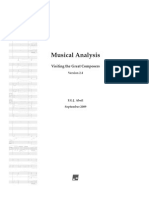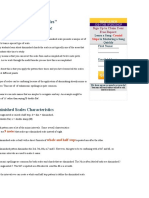Ear Training - From The Mind To The Fretboard
Ear Training - From The Mind To The Fretboard
Uploaded by
johnnyd1234Copyright:
Available Formats
Ear Training - From The Mind To The Fretboard
Ear Training - From The Mind To The Fretboard
Uploaded by
johnnyd1234Original Title
Copyright
Available Formats
Share this document
Did you find this document useful?
Is this content inappropriate?
Copyright:
Available Formats
Ear Training - From The Mind To The Fretboard
Ear Training - From The Mind To The Fretboard
Uploaded by
johnnyd1234Copyright:
Available Formats
Ear Training - From the mind to the fretboard
For a guitarist, or any other instrumentalist for that matter, one of the biggest obstacles is translating the sounds in our head onto our instrument - in our case, the fretboard. Vocalists certainly have it easier in this regard. When you envision a sound in your head, you can readily open your mouth and create that sound. The translation from the mind to the instrument (i.e. voice) is effortless and unconscious. Guitarists don't have it that easy. But we can get there. If you speak to an accomplished jazz player, more often than not you will find that their seemingly un-exhaustive ability to improvise on the fly comes from being able to play the lines they are hearing in their head. So how do you get started on this path to musical expressiveness? With ear training! Before we begin this journey, we need an ear training resource. While there are certainly a great deal of software packages available, my tool of choice is the following website: http://www.good-ear.com/servlet/EarTrainer Ear Trainer is a free, web-based tool with useful features such as tempo adjustment, and automatic scoring just to name a couple. You will notice that there are a variety of ear training categories intervals, chords, scales, etc. We are going to focus on intervals, since they are the fundamental building block for scales and chords. When just starting out, it is best to keep the "fixed root" option checked off. With this option, the intervals you hear will always start with the same note. This way, you will really get a feel for the differences amongst the various intervals. Are you ready? Let's get to it then. Click on the "Beginner" link to the far left. You will then see additional links below "Beginner". Now click "Simple Intervals". (Note: Ear Trainer uses MIDI to play notes. If you are using Windows XP, then MIDI playback should be automatically configured. If you do not hear any notes, then you need to do some configuring, which is beyond the scope of this article.) You should hear a series of two notes. You then have 4 options to choose from:
1. Prime - the most basic interval, this is simply the same note played consecutively. 2. Major 3rd - this interval contains 2 notes spaced 2 whole steps apart (such as C to E, G to A, etc), and has a familiar uplifting, happy quality. 3. Perfect 5th - this interval spacing is 3 1/2 steps (C to G, G to D, etc). The so called 5chords (C5, D5, etc) used extensively in rock and roll are based on this interval. 4. Octave - this interval consists of the same two notes played an octave apart.
The key to developing a good ear is to come up with your own meaningful associations. You need to make it real. One of the best approaches is to associate each interval with a familiar tune. For instance, when I hear a major 3rd, I think of the "Star Spangled Banner". At the beginning, the words "say can" are a major 3rd apart. Likewise, I have a unique association for the perfect 5th. I think "Top Gun". Remember that really nice, melodic guitar instrumental in that movie? The one played by Steve Stevens? Those first two notes are a perfect 5th apart. "Star Wars" may be more familiar. The
first two notes of that famous theme are also a perfect 5th apart. So you get the point. Each interval needs to be personal for you. They need to evoke a response. When you are correctly identifying a majority of the simple intervals, it is time to move on to more difficult exercises. Ultimately, you want to end up at the "chromatic intervals up/down" exercises, which you will see after clicking the "Intervals" link. Furthermore, you should deselect the "fixed root" option, so that you become accustomed to identifying intervals across a wide tonal range. Before we talk about identifying intervals, let's take a look at how intervals appear in standard notation and on the fretboard. In what follows, "m" stands for minor, "M" is major, and "P" is perfect. The image below shows one possible layout of the intervals in TAB notation. You should be aware that because of the guitar's ambiguity (i.e. identical notes appearing in multiple locations), there are a variety of possibilities. And most importantly, you should realize that even though this example shows the intervals starting from C, the patterns remain the same anywhere on the fretboard, regardless of the starting note. Regarding the standard notation, note how each interval is a half step higher than the previous one. This gives rise to the term chromatic intervals.
Now that you understand how the various intervals are defined, you are ready for the challenge learning to recognize them! Here is a list of all the intervals that you will need to be able to identify in the "chromatic intervals up/down" exercises. I have added comments about each interval, which will help you identify them by sound.
Interval Prime m2
Tips for recognition The prime interval, also known as the unison, is simply 2 identical notes. Recognized as the ominous "Jaws" theme! Also the beginning of the main melody from "Fr Elise".
M2
Think "Happy Birthday". The 2nd and 3rd notes comprise a M2 (i.e. the last syllable in "Happy" and the first syllable in "birthday"). My association here is from one of my own songs (that is the best way to associate create your own music!). I also associate it with the first 2 notes of the most popular scale in rock music - the Pentatonic Minor. For instance, with G Pentatonic Minor, the G to Bb is a minor third. As mentioned above, I think about the words "say can" (as in "Ohh say can you see") in "Star Spangled Banner". I associate this with Mozart's "Eine Kleine Nachtmusik", whose opening 2 notes comprise a P4. Another good example is "Here Comes The Bride". The words "Here comes" constitute a P4.
m3
M3
P4
This interval goes by many names, but I think tritone is the most useful name in the context of tritone chord substitution (which I will get around to talking about Tritone sometime!). I don't have any song associations with this one. I simply associate it with the characteristic sound of diminished chords and arpeggios - namely, a very ominous, haunting sound. P5 Like I mentioned earlier, I associate this interval with the first two notes of "Top Gun" theme. If you don't know what I am referring to, then just think about the first two notes of the famous theme from "Star Wars"! This interval reminds me of the song "The Entertainer". If you don't know the song by name, then you surely know it by sound. I suggest listening to this song. The very familiar opening, with the series of repeated notes, make up a m6. I don't associate this interval with a particular song. Instead, I am instantaneously reminded of a lick that is very common in blues music. Just play this interval and I think you will see what I mean! We are getting into difficult territory now. I associate this interval with another of my own songs. Supposedly the Star Trek theme starts with a m7, but I personally have no idea what the theme is. I do have a trick though. In my mind, I hear the higher note as an octave lower. So say the interval is C to Bb, as shown below:
m6
M6 m7
In my head, I end up hearing the following:
And so it has the quality of a M2 interval, and I associate it with the m7. As with the m7, this is a difficult one due to the lack of popular tunes to associate it with. I recognize this based on its quality. It is very dissonant. Like the m7, I use the trick where I envision the high note being played an octave lower. So consider C to B as shown below:
M7
In my head, I end up hearing the following:
And so it has the quality of a m2 interval. Octave An octave is similar to the prime interval, except that the notes are an octave apart. The first two notes in "Somewhere Over The Rainbow" are an octave apart.
m9 M9
Don't be thrown off by these so called extended intervals. These are a breeze. The m9 sounds just like a m2, except the upper note is played an octave higher as compared to a m2. So the quality is identical! Just as the m9 is identical in quality to the m2, the M9 is identical in quality to the M2.
You are now well armed to tackle the "chromatic intervals up/down" exercises. These will be considerably more difficult than the simple exercises, but by using the above information you may surprise yourself at how quickly you make progress! That concludes this article. I hope some of the concepts that I have discussed become truly meaningful as you pick up the guitar and apply them. You may not appreciate it a day or two later, but if you stick with it for at least a month, I think you will find that the portion of your mind dedicated to music has expanded!
You might also like
- Mixing Heavy MusicDocument66 pagesMixing Heavy MusicBảo ĐoànNo ratings yet
- A Little History of MusicDocument308 pagesA Little History of MusicnadaNo ratings yet
- Riemann English TranslationDocument900 pagesRiemann English TranslationIacob Hilda67% (3)
- Whole Chord ThingDocument76 pagesWhole Chord ThingEasonNo ratings yet
- Notion 4 ShortcutsDocument3 pagesNotion 4 ShortcutsQuinn MasonNo ratings yet
- Redsound Darkstar Xp2 ManualDocument36 pagesRedsound Darkstar Xp2 ManualHumberto Humberto0% (1)
- Lesson 1. The Concept of Tonality & The Sound of T He Home Base'Document8 pagesLesson 1. The Concept of Tonality & The Sound of T He Home Base'Paolo_Tacchini_2220No ratings yet
- An Incomplete Crash Course in Contemporary Music Theory: The FundamentalsFrom EverandAn Incomplete Crash Course in Contemporary Music Theory: The FundamentalsRating: 5 out of 5 stars5/5 (1)
- On The Twelve Basic IntervalsDocument14 pagesOn The Twelve Basic IntervalseditorialIANo ratings yet
- STrORrLUQmi7DzX7u1Hr Orchestration EssentialsDocument9 pagesSTrORrLUQmi7DzX7u1Hr Orchestration EssentialsClément PirauxNo ratings yet
- Musical TextureDocument2 pagesMusical TextureAmy DunkerNo ratings yet
- OUR Quick Reference Guide TO Using Chords: Master Chords in Your MusicDocument13 pagesOUR Quick Reference Guide TO Using Chords: Master Chords in Your MusicRitik Singhal100% (1)
- Brief History of Karnatic MusicDocument59 pagesBrief History of Karnatic MusicJack DuarteNo ratings yet
- Understanding 4+Note+Chords From+the+Major+ModesDocument10 pagesUnderstanding 4+Note+Chords From+the+Major+ModesAnonymous mowzCsSNo ratings yet
- Piano IntervalsDocument8 pagesPiano IntervalsgernNo ratings yet
- Cosas Chopin EtudesDocument5 pagesCosas Chopin EtudesDaniel GregorioNo ratings yet
- Notes On History and Theory of Classicalmusic Abstract Art MusicDocument72 pagesNotes On History and Theory of Classicalmusic Abstract Art MusicAurora SeasonNo ratings yet
- Week 9 - Song Mapping CompressedDocument21 pagesWeek 9 - Song Mapping Compressedapi-263507178100% (1)
- Intervals: The DNA of MusicDocument8 pagesIntervals: The DNA of MusicLeslie CharlesNo ratings yet
- Establishing The Elements of Music GroundworkDocument25 pagesEstablishing The Elements of Music GroundworkRacheal Mukiri100% (1)
- Using Binary Numbers in Music: Vi Hart Music Department Stony Brook University Stony Brook, NY, USADocument4 pagesUsing Binary Numbers in Music: Vi Hart Music Department Stony Brook University Stony Brook, NY, USANEmanja Djordjevic100% (1)
- Musical Analysis: Visiting The Great ComposersDocument111 pagesMusical Analysis: Visiting The Great Composerskaam24No ratings yet
- Math, Music and Memory Fall 2014 Handout For Sections 2.2 and 2.3: Scales and IntervalsDocument5 pagesMath, Music and Memory Fall 2014 Handout For Sections 2.2 and 2.3: Scales and IntervalsAudi GohNo ratings yet
- Cine Samples ManualDocument12 pagesCine Samples ManualAlexis PeguerosNo ratings yet
- 04 SoloingDocument1 page04 Soloingsuzytwo100% (1)
- 3+ +Improv+BootcampDocument28 pages3+ +Improv+BootcampBumjong KimNo ratings yet
- The Basic Elements of Music 8.8Document111 pagesThe Basic Elements of Music 8.8Sacred Heart Academy of La Loma100% (1)
- Music TimingDocument5 pagesMusic TimingFirerri TanNo ratings yet
- Truthhertz: Anybody Use The Goodchord Voice Leading Books?Document92 pagesTruthhertz: Anybody Use The Goodchord Voice Leading Books?Micro StepNo ratings yet
- Contemporary Songwriting TechniquesDocument10 pagesContemporary Songwriting Techniquesvikas kunduNo ratings yet
- Klasicna Gitara Dnevni Raspored +++Document7 pagesKlasicna Gitara Dnevni Raspored +++Roga29100% (1)
- Learn How To Play The Jazz 251 Chord Progression On Piano!Document4 pagesLearn How To Play The Jazz 251 Chord Progression On Piano!abel habtamuNo ratings yet
- Four Chord Song ProjectDocument8 pagesFour Chord Song ProjectJonathan Scott - Music Teacher (BIS HN)No ratings yet
- Acoustics PresentationDocument33 pagesAcoustics PresentationYourBestFriemdNo ratings yet
- DOMINANT SCALE 1 According To Barry Harris - FOR ALL INSTRUMENTS - Nestor Crespo / WWW - Serie20y20.com - ArDocument14 pagesDOMINANT SCALE 1 According To Barry Harris - FOR ALL INSTRUMENTS - Nestor Crespo / WWW - Serie20y20.com - ArNestor CrespoNo ratings yet
- Behind The Notation - Chord Symbols - Noteflight NotesDocument4 pagesBehind The Notation - Chord Symbols - Noteflight NoteskuaxarkNo ratings yet
- Major Minor Pentatonic ScalesDocument5 pagesMajor Minor Pentatonic ScalesWilNo ratings yet
- Theory: JPS Podcast 69 - The JPS SystemDocument4 pagesTheory: JPS Podcast 69 - The JPS SystemAlejandro ÁlvarezNo ratings yet
- VocalStudent Presentation GuideDocument41 pagesVocalStudent Presentation GuideDale GrossNo ratings yet
- Primo Theory Volume 5 Secured - Unlocked PDFDocument60 pagesPrimo Theory Volume 5 Secured - Unlocked PDFmsmali100% (1)
- Counterpoint Study GuideDocument1 pageCounterpoint Study Guiderhino777No ratings yet
- Compression Fundamentals Course NotesDocument7 pagesCompression Fundamentals Course NotesjoneNo ratings yet
- The Many Moods of Musical ModesDocument15 pagesThe Many Moods of Musical ModesRobertNo ratings yet
- A Perceptual Model of Pulse Salience and Metrical Accent in Musical RhythmsDocument56 pagesA Perceptual Model of Pulse Salience and Metrical Accent in Musical RhythmsAgustin Bandi100% (1)
- Musical Understanding PDFDocument16 pagesMusical Understanding PDFAndré BorelaNo ratings yet
- Arranging L2 Quiz: Luis Pinedo 13/13 100.00% 1Document3 pagesArranging L2 Quiz: Luis Pinedo 13/13 100.00% 1Charlie PinedoNo ratings yet
- The Tritonet Approach To Music Theory PDFDocument30 pagesThe Tritonet Approach To Music Theory PDFSelçuk Canberk DağtekinNo ratings yet
- Chart Reading. SwingDocument2 pagesChart Reading. SwingDarwin GuanopatinTutasigNo ratings yet
- Harmony ExplainedDocument102 pagesHarmony ExplainedNagakoIshamiNo ratings yet
- Band in A Box 2007 ManualDocument465 pagesBand in A Box 2007 ManualFlorianMartinezNo ratings yet
- Density Degree of Intervals and ChordsDocument16 pagesDensity Degree of Intervals and ChordsClaudio Maioli100% (2)
- Developing Musical StructuresDocument7 pagesDeveloping Musical StructuresVeron PabonNo ratings yet
- How Digital Audio WorksDocument11 pagesHow Digital Audio WorksPhan Giang ChâuNo ratings yet
- Intervals 4Document3 pagesIntervals 4edwardriches8561No ratings yet
- On Variation and Melodic Improvisation inDocument3 pagesOn Variation and Melodic Improvisation in3426211No ratings yet
- "Diminished Scales": The Tension Scale!Document4 pages"Diminished Scales": The Tension Scale!David NobleNo ratings yet
- Scott W. Extended ChordsDocument2 pagesScott W. Extended ChordsAnonymous KMVhQx5i3nNo ratings yet
- Berklee Keyboard Chords PDFDocument4 pagesBerklee Keyboard Chords PDFalbe angkasaNo ratings yet
- Music Theory: DiscoveringDocument5 pagesMusic Theory: DiscoveringAby MosNo ratings yet
- Reading Music Guide PDFDocument3 pagesReading Music Guide PDFOliver WarrenNo ratings yet
- Venom Audio Plug-In Documentation: Installation UnlockingDocument10 pagesVenom Audio Plug-In Documentation: Installation UnlockingClement BattungNo ratings yet
- Peter Mole PHD Thesis 2009 Volume 1Document395 pagesPeter Mole PHD Thesis 2009 Volume 1Mario Marcal JrNo ratings yet
- Jamey Aebersold LinksDocument38 pagesJamey Aebersold LinksDino ContentiNo ratings yet
- HVAC Systems Noise ControlDocument109 pagesHVAC Systems Noise ControlYaseen MallickNo ratings yet
- Harmonic Minor Scales - Trumpet - LexcerptsDocument12 pagesHarmonic Minor Scales - Trumpet - LexcerptsLexcerptsNo ratings yet
- Catalogue Daikin FT25 FT35 (R410A)Document79 pagesCatalogue Daikin FT25 FT35 (R410A)songque_tk100% (1)
- Rggupta Chapter 1 To 3Document72 pagesRggupta Chapter 1 To 3Krishan Pal SinghNo ratings yet
- Lets Play Clarinet SampleDocument65 pagesLets Play Clarinet SampleFabrizia Labianca100% (1)
- Kostka7e IM Ch01Document10 pagesKostka7e IM Ch01chenamber100% (1)
- Tuba SyllabusDocument5 pagesTuba SyllabusNeri RochaNo ratings yet
- Hugo Riemann - Harmony SimplifiedDocument94 pagesHugo Riemann - Harmony SimplifiedDewdman42100% (1)
- Tonal-Harmony - Copia (PDF - Io) (2) 2.1Document35 pagesTonal-Harmony - Copia (PDF - Io) (2) 2.1Alejandro MoraNo ratings yet
- Musical Harmony, Mathematics, and Esotericism: Celeste Jamerson and John F. NashDocument28 pagesMusical Harmony, Mathematics, and Esotericism: Celeste Jamerson and John F. NashFrancisco MoserNo ratings yet
- Csound FLOSS ManualDocument343 pagesCsound FLOSS ManualIsraelNo ratings yet
- Supply Air DiffuserDocument6 pagesSupply Air Diffuserntt_121987No ratings yet
- Intervals: Melodic Intervals Harmonic Intervals Interval Inversions Perfect IntervalsDocument13 pagesIntervals: Melodic Intervals Harmonic Intervals Interval Inversions Perfect IntervalsJonathan ScottNo ratings yet
- Lourve: Product InformationDocument8 pagesLourve: Product Informationntt_121987No ratings yet
- Alfredo Capurso - The Circular Harmonic Temperament System - C.HA.S. ®Document13 pagesAlfredo Capurso - The Circular Harmonic Temperament System - C.HA.S. ®22nd Century MusicNo ratings yet
- IntervalsDocument11 pagesIntervalsVee CuentasNo ratings yet
- Learning and Playing The Modes of The Major ScaleDocument74 pagesLearning and Playing The Modes of The Major ScaleEuan Richard100% (1)
- The Paradox of Pitch Circularity-Diana Deutsch-Escher-Shepard ToneDocument8 pagesThe Paradox of Pitch Circularity-Diana Deutsch-Escher-Shepard TonetobysebasNo ratings yet
- ASTACAP Level RequirementsDocument60 pagesASTACAP Level RequirementsGabriel DixonNo ratings yet
- Acoustics From Oxford Companion PDFDocument17 pagesAcoustics From Oxford Companion PDFMegan Griffith100% (1)
- AANE13-07-05-arqueologia Musical Antigo Oriente Médio PDFDocument527 pagesAANE13-07-05-arqueologia Musical Antigo Oriente Médio PDFtalespinto100% (1)
- Hugo Riemann - Harmony SimplifiedDocument216 pagesHugo Riemann - Harmony SimplifiedSrgio Kno100% (4)

























































































